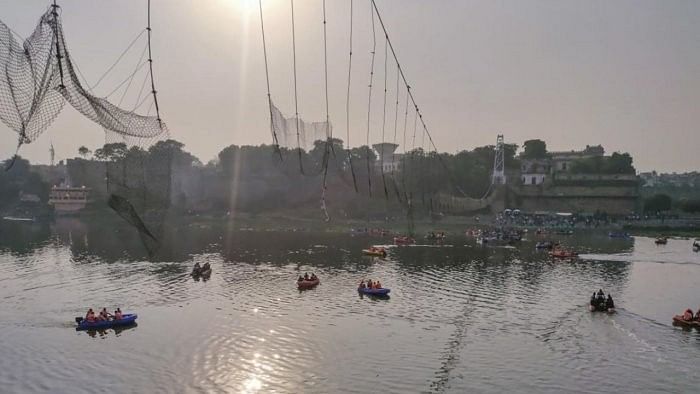
Bridge collapse in Morbi.
Credit: PTI Photo
A special investigation team (SIT) on Tuesday filed its final report on the bridge collapse in Morbi which killed 135 people last year during Diwali festivities.
The report concluded that "the incident is a result of lapses at administrative level to follow due procedure as per government norms and also due to technical incompetence to repair the bridge and test it before opening it to the public."
"Prima facie, the whole management of Oreva company, (the clock-making firm responsible for managing the bridge) including its managing director (Jaysukh Patel), two managers (Dinesh Dave and Deepak Parekh), appear to be responsible," the SIT said in the report.
The report was filed in the High Court which is hearing a suo motu PIL. During the hearing on Tuesday, the division bench led by Chief Justice Sunita Agarwal asked the advocate general, Kamal Trivedi, if the company could be black listed.
The remark came after court was informed that Oreva had taken the responsibility of managing the bridge "voluntarily." The bench also sought action taken by the company with regard to seven children who were orphaned in the tragedy. The court also asked if the affected women could be given jobs.
The report read, "The lackadaisical approach on the part of the management of OREVA company, resulting into one of the most severe and tragic human calamities, can't be countenanced," adding that "there were serious operational and technical lapses on part of Orewa company's management."
The British-era suspension bridge on the Machchhu river in Morbi had collapsed on October 30 last year, killing 135 people and injuring 56 others. Ten people including Jaysukh Patel, the managing director of the clock-making firm, were arrested following the tragedy. The Morbi Nagarpalika had signed a contract with Oreva for "management, maintenance and operation" of the bridge. The report stated that Oreva outsourced the repair work to a firm, Dev Prakash Solution without taking any technical opinion of an expert agency.
The report stated that before opening the bridge to the public, the company ought to have obtained its fitness certificate and informed the Morbi municipality.
On administrative lapses, the SIT has said that three members of Morbi municipality including then president, then vice-president and then chairman of executive committee are responsible for not bringing the agreement (with Oreva) to the general board.
The report also highlighted several design faults in the bridge post-renovation works such as replacing wooden panel deck by aluminium honeycomb deck which led to its collapse, among other factors. The report recommended a log book to be maintained for all public bridges and their periodic inspections.
"CCTV footage, site observations and the investigations, the breaking of the main cable on the upstream side of bridge ie on the Darbargadh side, found to be the main cause of failure of suspension bridge at Morbi", the report concluded.
"Considering all the safety aspects and design calculations, safe live load capacity of the bridge may be taken maximum 75 to 80 persons at a time (if all 49 wires were in working condition). But as per site observation, 22 wires out of 49 were already broken due to corrosion, therefore safe live load capacity of the bridge may have been drastically reduced."
Citing CCTV footage, the report said that a large number of people were standing over the bridge deck, indicating overloading the structure before failure.
It said that original construction of the bridge was done in 1887. Considering weathering effect, ageing effect, and non uniform loading pattern with higher intensity of load coupled with overloading are the cause of the failure of main cable at pulley location.